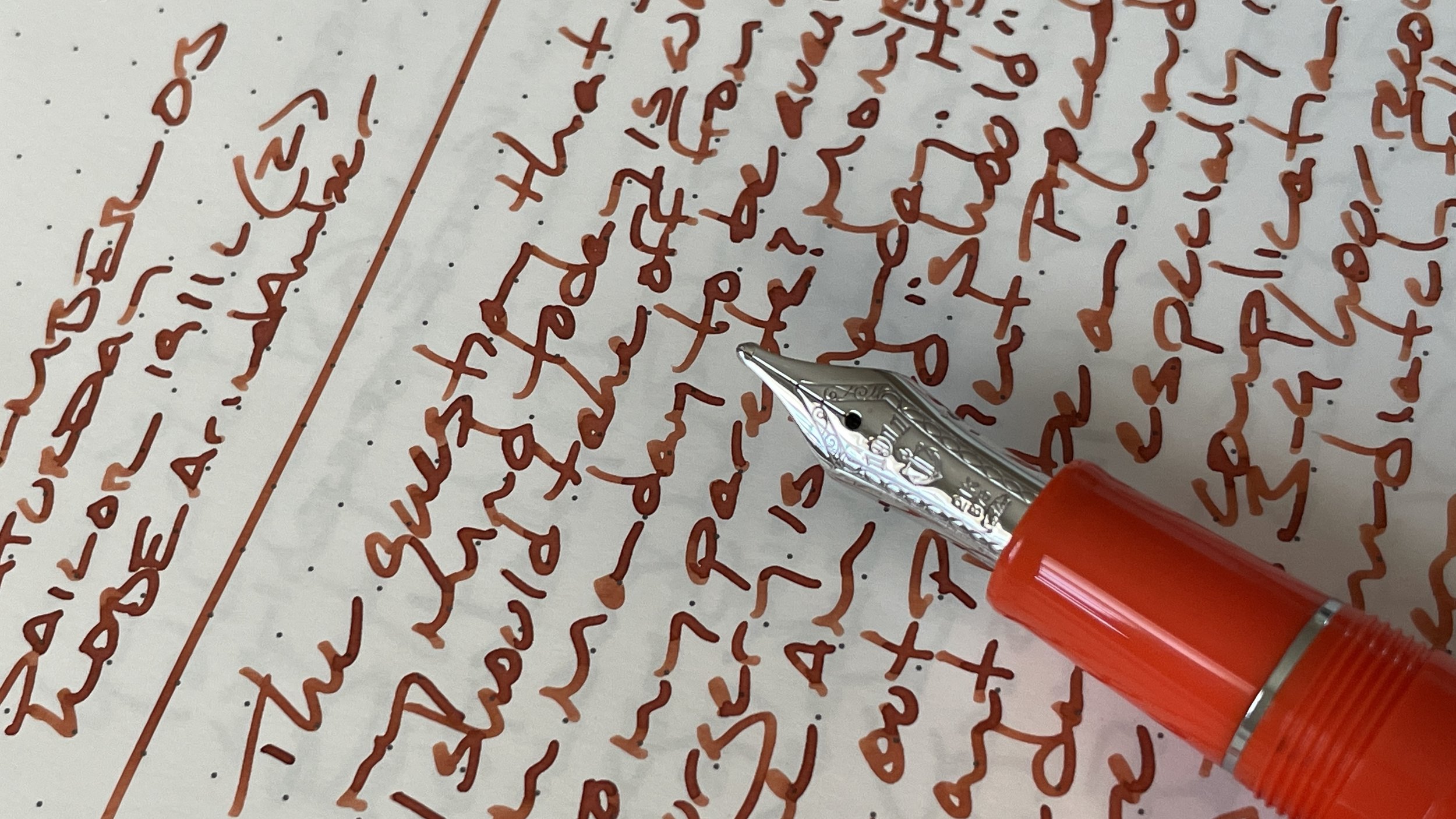Thinking backwards to plan forwards
Planners are tricky propositions. Each year I plan out an intentional workflow for how my analog planner can support me in the year to come.
January arrives with an exciting revised strategy for how my planner will help me to revisit and meet my personal goals. How the tidy notebook will keep me on top of those mundane household tasks that simply need doing. And how I can squeeze enjoyment out of both.
And my planning plans inevitably, invariably, inescapably fall short.
And yet my plans also always seem to improve year-to-year. Because I learn from how the prior year’s tracking and planning adventures played out. Heaps of mistakes lead to heaps of lessons. Science, Dr. Farnsworth reminds us, cannot move forward without heaps.
Last year’s planner plan made the Hobonichi Day-Free the center of my planning world. Parts of the plan work very well. Parts show promise. And still other parts of the plan burped and burned.
I’m thinking backwards to better plan for next year’s approach.
The good. What went to plan. The heart of my personal productivity plan this year is the monthly pages in my A6 Hobonichi Day-Free. The compact 6x7 3.7mm gridded cells provide excellent for tempering my productivity goals to doable amounts.
I’ve learned that I can complete one or two personal tasks on any given day. The diminutive daily boxes are just the right size for what I can get to in a day. Any task that requires more space to record will likely also need more than one day to complete.
Size, it turns out, does matter
The less-good but still positive. I converted Hobonichi’s pre-printed Favorites list into a log of the books I’ve read throughout the year. Having this log in the back of my planner is gratifying. Proof positive that tracking hobbies encourages me to engage more with my hobbies.
Still figuring out how to use the iconography
I also recorded each week’s currently inked pen-and-ink pairings in the blank pages at the rear of the notebook. Having my inks in-pocket proved valuable. I routinely confirmed my inks and nibs. Because my notebook is my short-term memory.
However, currently inked logs take up, at most, 60 pages. Of 171 empty pages.
Lastly, I installed a plastic pocket on the inside of the rear cover. This pocket houses Tsubame cards. Each card logs a pen and ink pairing. I keep my favorites to ease decision-making when I plan out each week’s currently inked.
Unconvinced the ink smear helps
The ugly. But there is likely another, more intentional, use for the extra 110 pages in the rear of my Hobonichi.
My use of these pages as only currently inked logs seems a waste of perfectly good paper. As such, I began using the rear pages for scratchings and samplings during pen meetups and at pen shows. The A6 notebook is easy to carry with me and offers paper I’m used to writing on — which is excellent for testing new-to-me inks and nibs.
I regularly forgot about the habit tracker I intended for the Hobonichi’s monthly overview charts. I found myself back-filling my habit tracker pages weeks at a time. Back-filling led me to feel as if I was tracking what I wanted to have done more than what I truly did.
Or just leaving echoing emptiness … empty … pty … y
I need a call to action for these opening pages. Perhaps a new prominent clip? Perhaps a phone reminder?
Plenty to learn from.
This week’s Inked Tines update includes last week’s currently inked writing tools.
Toolset
Pens. I ran the Pilot Custom 74 and its EF nib empty a second time in two weeks — off of a partial fill. A perfect combination of ink and nib. The EF lines were clearly legible and disciplined. The ink flow was consistent. And Downpour still managed to shade prominently. Fabulous. Task management, reading notes, meeting notes, commonplace notes, and scratch notes.
Able Snail Classic (B) — 1/3. Sakuranezumi reigned in this generous B nib. The result was narrow B lines and quick dry times. Perfect for accent notes during meetings. And reading notes.
TWSBI Vac700R (F CSI) — 1/3. Wrote more and more dryly as the month of inked life wore on. Hisoku’s whispy hue is an excellent annotation ink while reading. Also: teaching notes, meeting notes, and task management accents.
Sailor 1911L (Z) — 2/5. The multitasker Zoom nib made this combo a great pocket carry. EF lines while reverse writing in my pocket notebook. B-width lines with excellent shading when writing normally. Commonplace notes, journaling, reading notes, teaching notes, and scratch notes.
Lamy Safari (B) — 1/2. Vert Empire would go on my shading inks hall of fame if I kept such a record. Flowed consistently every time I uncapped this pair. Journaling, reading notes, commonplace notes, pocket notes and a few letters.
Sailor Pro Gear (MF) — 1/2. Aonibi is moderately wet in this particular nib and feed. Invitingly so. Excellent for notetaking during meetings, understated reading notes, lesson plan outlines, and some commonplace notes.
Notebooks. Work bujo. Odyssey Neptune 400 (A5). I added eight new pages to my work bullet journal through last week. Overall, I taught three days — with Monday and Friday off. Eight pages across three teaching days is on par with my typical writing volume. Normalcy.
My weekly two-page spread begins the week’s notes. Monday turned into a remote-work day for me. I knocked out five major administrative tasks. All triply status-tracked in their task list boxes. All in Downpour’s personable purple-infused grey.
Plus one chubby, homework-assigning penguin
I sketched out two separate lesson plan outlines. One for my world history class. The Able Snail’s B lines and murky purple ink contrast easily from the Pilot’s hair-thin EF structure.
Complimentary purple tones, too.
Another page is home to a table I use to plan out my homework calendar. I work three weeks in advance so my students can plan their time around busy family and extracurricular obligations.
Lesson numbers are laid out in grey ink. I use accent colors (Amber for my history class and Sakuranezumi for my research class) to track which assignments are visible to students on the calendar.
Pretty penned progress
Two final are replete with meeting notes. All in Downpour’s grey and Hisoku’s blue. A week’s writing that ends on page 237.
Journal. Endless Recorder in Mountain Snow (A5). I enjoyed a light week of personal writing. Only three pages of journaling. Two entries.
Consistency — worlds away from daily consistency — lives outside of my equation for a successful journaling habit. Journaling is about continuation for me. I’m winning if I open the book and start a new entry.
And I did so twice last week.
Winning.
Written dry. I quarter-filled the week’s daily driver: the Pilot Custom 74.
I subsequently learned that a quarter-filled Con-40 converter lasts three work days.
Just enough ink. Just enough pen.
Newly inked. I reinked the Pilot 74 for last week. A rare practice. The pairing of Dominant Industry Downpour and Pilot’s lovely EF nib was superb.
I change inks often. Excitement over new inks draws me back to my desk — even when I’d rather not be productive. Changing inks, for me, is a productivity tool. And fun.
So, reinking my daily driver last week was high praise for the pen-and-ink combo.
The collection
Incoming / new orders. I introduced a new brass three-pen rest to my work desk kit. The rest houses my primary writers while teaching, in-between bouts of lesson planning and school meetings.
And the little Walden Woodworkers pen rest is a hit.
I alternate between two desks in my classroom: a while-I-teach desk and a teaching-prep desk.
A wonderful A4 leather folio is the center of my prep desk workflow. It serves as a desk organizer. Four fountain pens and a grey Mildliner grace the pen slots at the top of the folio. And both my A6 Hobonichi and A6 Stalogy pocket notebook can fit in the folio’s interior holders. Everything has a home.
However, my pens and pencils and highlighters lay strewn about the desk at the front of my classroom. It’s a transitory space.
I found myself in need of an easily moved, secure pen organizer. Enough to hold the three pens I use while teaching.
It works quite well — on both desks. Just large enough to accommodate two girthy pens like the Mythic Aeschylus or the TWSBI 580 and one slim pen at a time.
The pen rest was a generous donation from the folks over at Galen Leather. Cheers.
Outgoing / trades or sales. No outward movement this week.
Currently reading and listening
Fiction. I continued my journey through the land of the Dragon Reborn this week. Another 43 iPhone-sized pages across five chapters. I’m presently on page 580 — 43% through The Gathering Storm.
All of my reading took place in Apple’s Books app.
Finally, at long last, all five main characters have made their appearances. I dig a book that can keep my attention across so many smaller storylines.
Nonfiction. My nonfiction attention was showered on converting the annotations in Fukuyama’s Liberalism and its Discontents into commonplace notes. A process for another post.
So: reflection on already-completed annotated reading. No new nonfiction pages this week.
Music. Slow Meadow played in my speakers all last week. Slow moving, brittle orchestration. Gentle midi and keyboard-driven arrangements that suit quiet, reflective reading sessions well.
And, as it turns out, Slow Meadow is excellent music for underneath teaching history classes.













